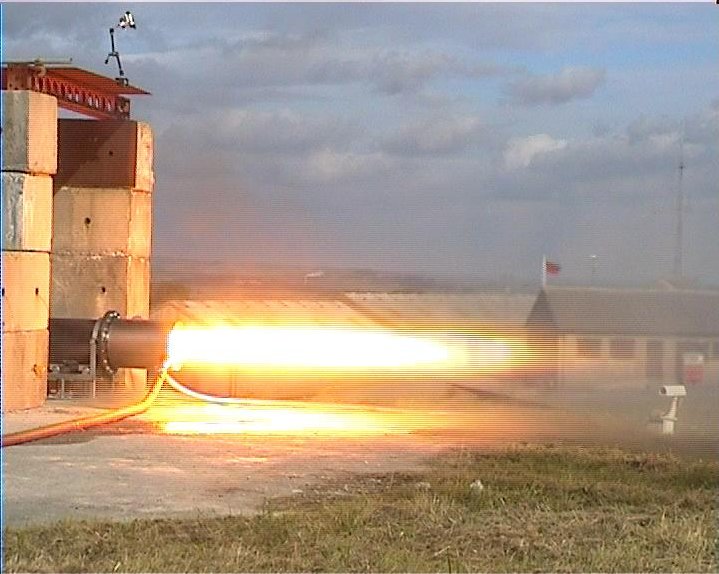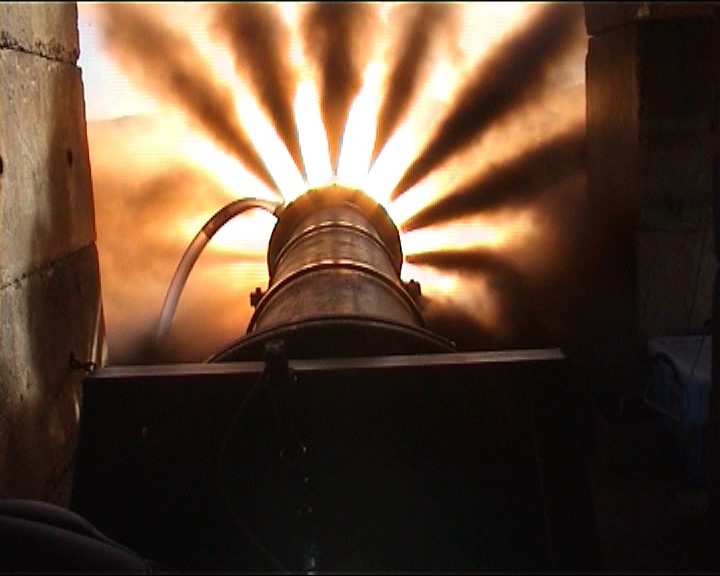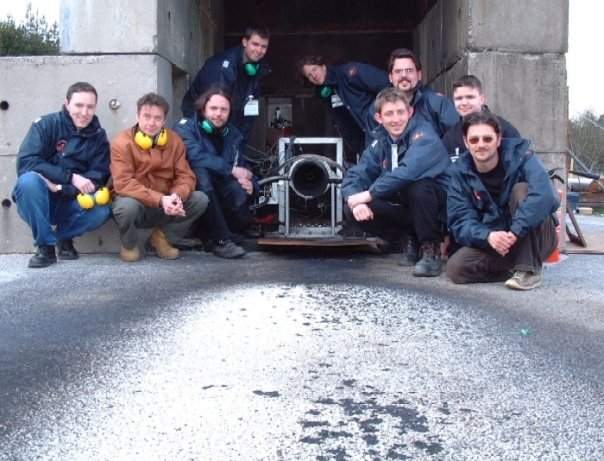





Isaac 2 ground test engine...
In 2001 I started work with Starchaser
in the hope of producing a large hybrid system for their X prize plans. Unfortunately this was not to be, but it was a very interesting experience.
The plan was to create a reasonably conventional multi-port hybrid engine so as to take advantage of a hybrid rocket systems potential safety,
simplicity and comparatively benign handling.
I think it's fair to say that much of the literature around hybrids and much of the existing research, at least at that time, was based around liquid oxygen/HTPB
rubber rocket engines. Cryogenic liquid oxygen is relatively benign, given proper handling, gives the greatest performance of the likely oxidiser candidates and is widely available.
HTPB, or hydroxyl terminated polybutadiene, rubber is the dominant fuel binder in modern solid propellant rockets and so many of the previous hybrid efforts had existing experience of this material.
In light of the information available, and the parallel LOX/Kerosene bi-liquid programme, we settled on the LOX rubber combination.
The first task was to secure suppliers for the propellants, which for HTPB is no mean feat, then to carry out subscale tests to measure the way the propellants behaved together. This was accomplished with the
100th scale Isaac 1. These tests proved to be a great learning experience in creating the solid fuel and handling LOX for the first 1.25 tonne Issac 2. Actually Isaac 2 itself was intended as a
subscale test engine; composing of a small combustion chamber (well small in this case meant 3 metres long and 355mm diameter) holding two full size fuel ports like those that would be used in a larger multi-port engine
It was my first attempt at a full size engine, and it was intended for ground test, which in retrospect led me to make it over complicated and over engineered.
It ended up much bigger and heavier than it needed to be, with all the attendant cost, delay and handling challenges that implies... But one has to begin somewhere.


By the end of September 2002 we were ready to test. We were fortunate enough to be able to test at the national Health and Safety Laboratory at Harpur Hill near Buxton, creating the safety case with them proved quite a task in itself, but was an invaluable process.
We planned to test Isaac 2 first and follow it with the 500 kg thrust Churchill 1 LOX/Kerosene Bi-liquid, designed by my fellow rocketeer and Salford alumnus Anthony Haynes, all over the course of two weeks.


First came an extensive trial by LOX valve; Two high pressure LOX ready solenoids supplied by a US manufacturer, one nicely degreased but with swarf stuck in the valve seat...And one that refused to operate
whenever any pressure (like atmospheric)... or cold liquid (like liquid oxygen)... was applied to it.... We were eventually rescued by BOC's excellent centre at Sheffield who supplied us with two new high pressure cryogenic ball valves.
Then by the 2nd of October we were ready to run. All systems checked, fuel in place, gaseous and liquid oxygen systems charged, video and load cell running we retired to a safe distance, and an armoured control shed...
The solid rubber fuel is quiet difficult to light so combustion is first established with a low pressure flow of gaseous oxygen. Once we had a a well established diffusion flame licking out of the nozzle I actuated the main LOX valve.
What occurred next actually all happened very quickly indeed, but seemed much longer at the time. The engine came up to full power with a nicely developed symmetrical exhaust plume; but very quickly flame
appeared along the line of the open metal roof of the test cell and then an impressive cloud of fire burped out of the engine and rolled out about a 100 metres over the grass.
I shut off the LOX and we went to investigate once everything was shut down and vented. The fuel was still smoldering away on a trickle of evaporating LOX caught in front of the valve, so it was sometime before the engine could be
opened up.
We found when we did that, shortly after the engine came up to full power, the rubber fuel block had begun to disintegrate from the nozzle end back up the engine.
This accounted for the fireball which was evidently a cloud of rubber particles continuing to burn after being ejected from the engine. Large lumps had also come loose, turning Isaac into the words largest rubber cannon;
fragments of rubber larger in diameter than the nozzle throat were found up to 400 metres away. This intermittent blocking of the nozzle also overpressurised the nozzle gasket, creating the spectacular star burst of exhaust seen in the above picture.
Subsequent analysis of the thrust data showed that, for the brief period all was working, Isaac 2 was actually within 0.3% of design thrust, at 1254kg rather than 1250kg, right out of the box! Plans were in place to
test Isaac again, the engine was modified and we found a much better method of creating the fuel blocks; but this unsuccessful, if spectacular, test was followed by five very successful runs of the Churchill 1 bi-liquid engine.
In light of the time pressure of the X prize and the budget constraints of a small company it was decided that the bi-liquids offered a more effective route to a practical propulsion system, and so Isaac 2 never ran again.
